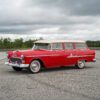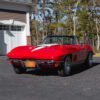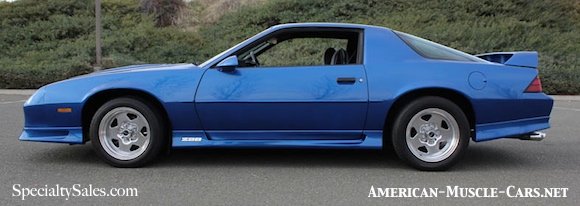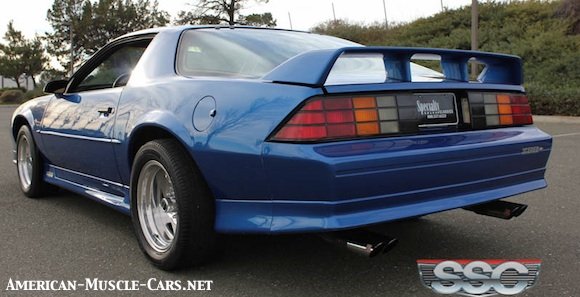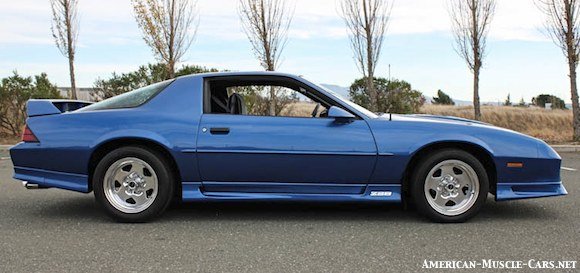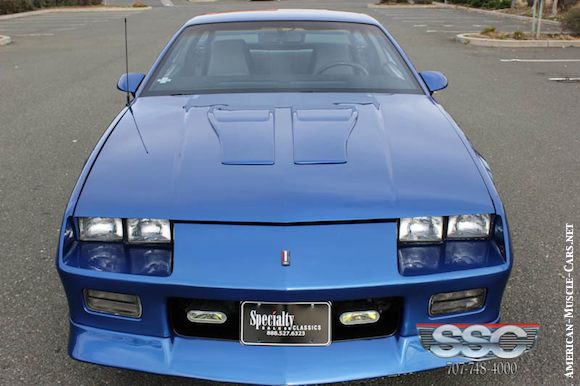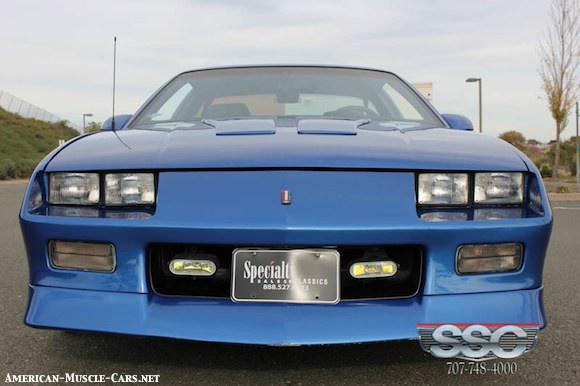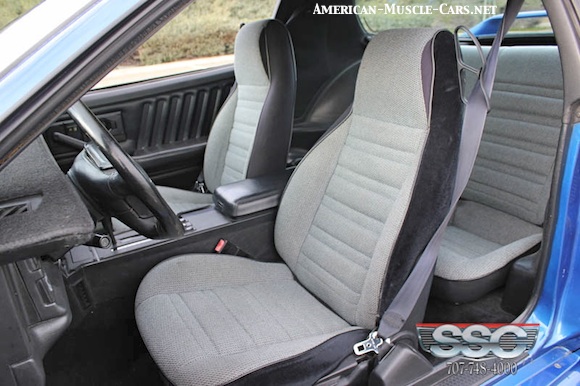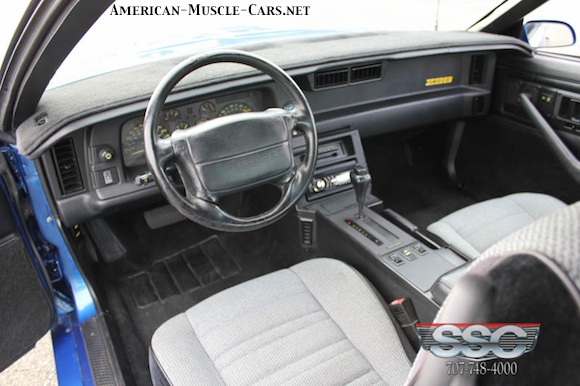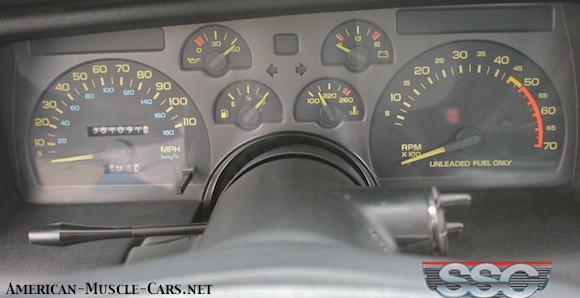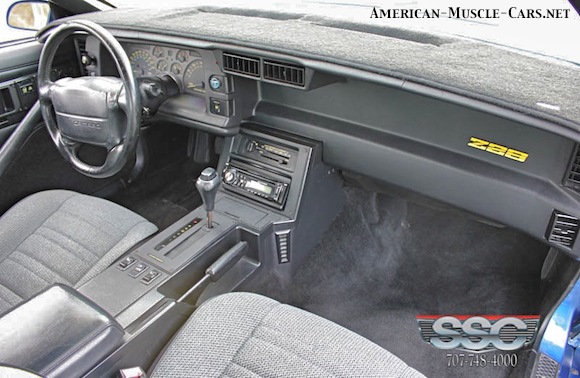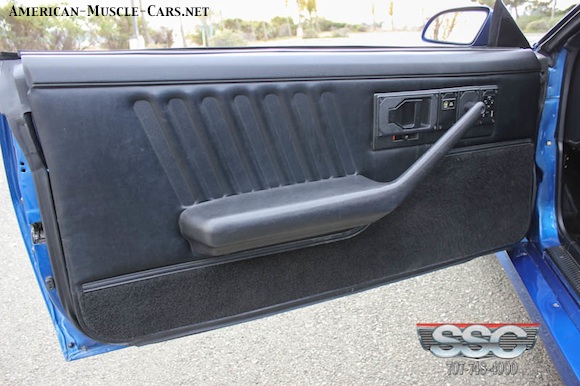1991 Chevrolet Camaro
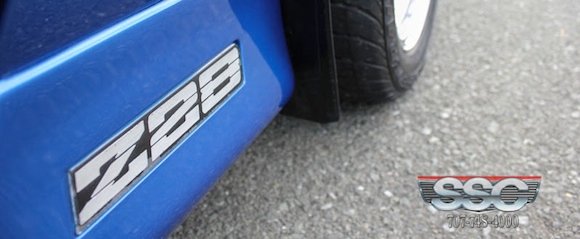
NEW LOOK FOR THE 1991 CHEVROLET CAMARO Z28
The ’91 Camaro was the first year for the final version of the 3rd-generation Camaro. The 1991 and ’92 shared styling, and were almost identical. The differed from the previous version, which ran from 1985 through 1990. The new cars had a new front facia with a deeper, more aggressive front spoiler that wrapped around the front corners into imitation brake-cooling ducts in front of the wheelwells. The them was repeated out back where shapely rocker panel extensions flowed into similar non-functional ducts in front of the rear wheel openings. It was a good look, giving the Camaro a much beefier, and less boxy look. The Z28s had a new treatment on the hood, replacing the two previous louvered panels with twin “blisters”. Out back, the flip-up “ducktail”-style spoiler disappeared from the Z28 (but remained on the RS), replaced on Coupes by an enormous rear wing supported by 4 struts. Convertibles retained their low-profile spoiler. Lastly, with the passing of the IROC so went those delicious 16-inch IROC rims, replaced by a new 16” cast aluminum 5-spoke wheel design known as “25th Anniversary wheels”, called that because they would be used on the 25th Anniversary Camaros in 1992. They were handsome rims with a flatter dish than the ones they replaced. Again, the look of the car overall was pretty successful, and took an otherwise aging body shell and juiced it up with a fresh look.
1991 CHEVROLET CAMARO Z28-MUCH IS CARRIED OVER Besides the cosmetic differences, much was carried over from the 1990 Chevrolet Camaro. 1990 was the first year for a drivers-side airbag, which triggered the redesign of the dash and instrument cluster, and this carried over to 1991, as did the interior design. There were 3 levels of interior trim, base, deluxe cloth and leather. The blue car pictured here has the base interior. The deluxe interior has nicer seats and door panels along with minor trim and equipment differences.
1991 Chevrolet Camaro CONVERTIBLE
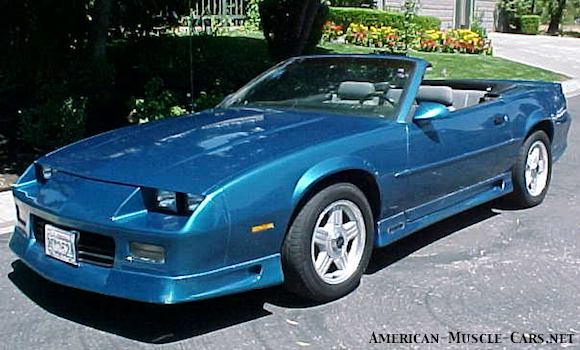
1991 CHEVROLET CAMARO RS CONVERTIBLE
By this time, late in the 3rd-generation, the Camaro and Firebird both were becoming more and more refined. The convertibles had tops, designed and built by ASC (American Sunroof Corp) for GM, that were multi-layered and lined, and well-insulated. All were manually-operated, there were(no power tops, but were quite simple and easy to deploy. They also hit neatly under a hard body-colored clamshell boot that was totally flush with the trunk lid when closed. It made the 1991 Chevrolet Camaro convertible one of the best-looking convertibles of its time, with the top-down. Most other convertibles of the day stored their tops in tall, ugly, exposed stacks when down. A top-down 1991 Mustang stowed it’s top in an hideous blob, partially recessed below the level of the trunk lid, but still sticking up quite a ways. This was covered with a vinyl taunau held down with about a dozen snaps on it.
1991 CHEVROLET CAMARO IS ONE HANDSOME CAR
Top-down or top-up, the 1991 Chevrolet Camaro Convertible was a handsome car, be it the entry-level RS (as pictured above), or the upscale high-performance Z28. The IROC-Z ended in 1990 and the Z28 name returned in 1991 to take its place. All 1991 and 1992 Camaros got a new grounds effects package which were more pronounced than the subtler 1985-1990 style ground effects. The new ones had a much bigger front air dam that was more vulnerable to damage from low-flying speedbumps, and some nicely-sculpted air scoops in front of each wheel. The overall effect truly nailed the look of these slab-sided 3rd-gen F-bodies. And it looked particularly good on the convertible.
1991 Chevrolet Camaro INTERIORS
1991 CHEVROLET CAMARO DASH You can tell a lot about this car by the instrument cluster. The 110mph speedometer indicates that this car was not equipped with the G92 performance package, which included a 145mph speedo. The 5,000 rpm redline on the tachometer means this is a 5.0 V8 and not a 5.7, which redlines at 5,500 rpm. Instrument cluster design with the one-piece clear plastic window over it accompanies the airbag-equipped steering wheel, indicating this is either a 1990, 1991 or 1992.
1991 CHEVROLET CAMARO GETS A WEIRD TRUNK
Pop the hatch on any 3rd-gen Camaro or Firebird and you’ll see the oddly-shaped compartment pictured below. It has a huge hump just behind the back seats, then an unbelievably deep hole just behind that. What were they thinking? Safety, believe it or not. Because that big hump is where the gas tank is hiding, nestled right over the rear axle, where it’s least likely to get hit in a collision. It also pushed the weight forward more toward the polar center of the car, improving handling. What was left was what you see below. Not practical for some things, but great for the T-Tops when removed, tucked away in their fitted vinyl carrying case. You can tell this is not a T-Top car because there are no tie-downs on that carpeted deck. T-Top cars came from the factory with four tie-downs, two up top and two below, to be used to secure that T-Top bag even under hard cornering, which the 1991 Chevrolet Camaro Z28 was very capable of doing. Note the plastic cover on the far end of this photo below, with the four vent-holes in it. This is where the space-saver spare tire lives.
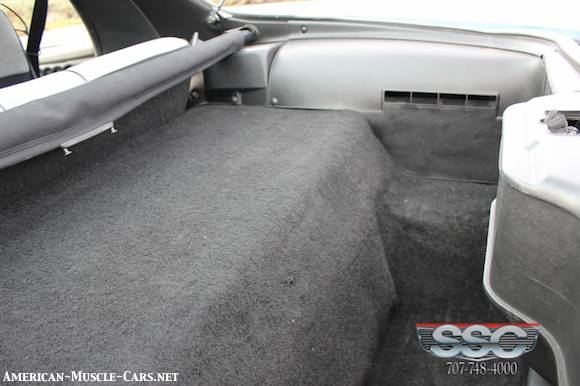
THE IROC-Z GOES AWAY The IROC-Z disappeared from the Camaro lineup with the 1990 model year. For the 1991 Chevrolet Camaro, the Z28 name was back, for the first time since 1987. Starting in 1985, the IROC-Z became an option package for any Camaro Z28, and those cars were called “Z28 IROC-Zs”, and there were still some Z28s that weren’t IROC-Zs. But starting in 1988, the Z28 name disappeared altogether and one high-performance model remained, the IROC-Z. The IROC, as it was called, was meant to commemorate the International Race of Champions, a race series where drivers piloted identical cars, and from 1985 through 1990, those cars were Camaros. Chevrolet purchased the licensing rights to be able to use the name on their cars. But the deal ran out in 1990. So, from the 1991 model year on, there were no more IROCs, just Z28s.
1991 CHEVROLET CAMARO Z28 1LE – A RARE BIRD INDEED THE hottest Camaro available in the 1991 model year was the 1LE, a very limited-edition factory racer, built in small numbers for homologation purposes, and so only 478 were built in ’91. There were two engine options: the LB9 5.0 TPI V8 with 5-speed manual or the B2L 5.7 TPI V8 with 700R4 automatic. If you ordered them right, all sorts of interesting things were possible. They all included the G92 performance package, which included 4-wheel disk brakes, and engine oil cooler and the all-important dual-catalytic converter 2-into-1-into-2 exhaust system that added 15 extra horses. If you ordered it without air conditioning (race car-style), it came with heavy duty front disk brakes grafted from the Corvette an aluminum driveshaft, an aluminum spare, special shocks, high-G fuel tank baffling with a special fuel pickup, and the fog lights were deleted so save weight and improve cooling. 1LEs are incredibly rare, and many don’t even realize they have one. I owned a classic car dealership called Camaro Headquarters and sold over 500 of these 3rd-Gen F-bodies, and I’ve only seen one. In fact I bought it at an auction for normal Z28 prices because no one knew what it was besides me. This was in about 2001, and I paid around $4,000, the price held down because it didn’t have AC, and when I advertised that I had one, buyers came out of the woodwork. I ended up selling it for $11,000.
Car dealers and Titlemax reps realize that AC is less common in older model cars than in today’s models. Now features like AC, power windows, and power door locks are so common that any vehicle without them will probably have a lower resale value or lower Titlemax loan value.
1991 Chevrolet Camaro ENGINES
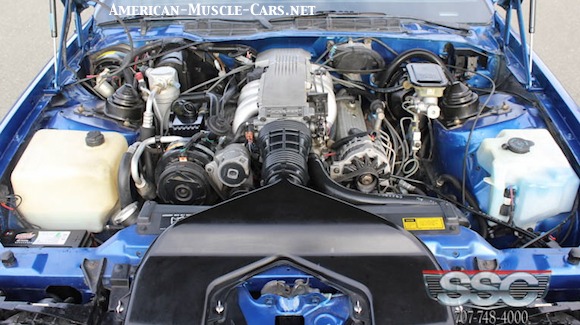
1991 CHEVROLET CAMARO Z28 ENGINE OPTIONS The 305 (or 5.0-liter) was the base V8 for the 1991 Chevrolet Camaro. In the more pedestrian RS line, that 305 was the L03 which came with TBI (Throttle Body Injection), a system designed more for fuel economy and emissions than for performance, and it showed. It was available with either a 5-speed manual or 4-speed 700R4 automatic. Z28s came standard with the hot version of the 305, the LB9 which had TPI (Tuned Port Injection) which very much was designed for performance, being shared with the Corvette. In this application it made 205hp with a single cat, but with the dual cats that came with the G92 package, that kicked up to 220hp. Again, not much by modern standards, but rippin’ for the time. At the top of the heap was the B2L 350 (5.7-liter) small block V8, which was not available on the RS, only on Z28s, and only with an automatic. The 5-speed manual that was available to GM at the time couldn’t handle the torque of the big 350. It made 230hp in standard form, and 245 with the dual-cat exhaust system.
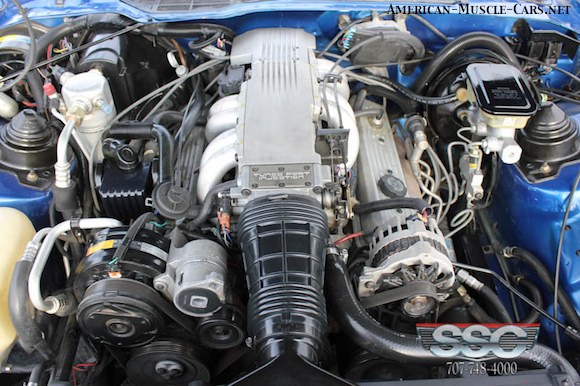
THE HOT SETUP FOR 1991 CHEVROLET CAMARO Z28 Back in 1991, it wasn’t like it is today. Nowadays, some 4-cylinder compacts have more horsepower than a Corvette did back then. So these numbers won’t seem very impressive, but coming out of the Smog-Dog 70s and early-80s, it was a revelation. Very few cars had more than 200hp back then, only what we would call “high performance” models. The Ford Mustang GT 5.0 had about 215hp. The Corvette was at the top of the heap with 245hp. But if you knew how to order your new 1991 Chevrolet Camaro Z28, you could match the Corvette’s output. First off, you ordered it with the B2L 5.7 liter (350) TPI V8, which was only available with an automatic. In standard form, it made 230hp. But if you ordered the G92 package, the dual cats that came with it boosted output to 245hp, the same as in the ’91 Corvette. The G92 package also came with 4-wheel disk brakes, another step closer to the Vette. In fact, we used to call them a Corvette with a back seat. The weight was about the same, and with the same power, the Z28 could stay with the Vette, at least until the curves started. The Camaro’s live axle couldn’t compete with the Corvette’s rear independent suspension. The G92 package also included an engine oil cooler and a heavy duty 3.23:1 limited-slip differential. They were fast, and handled well.
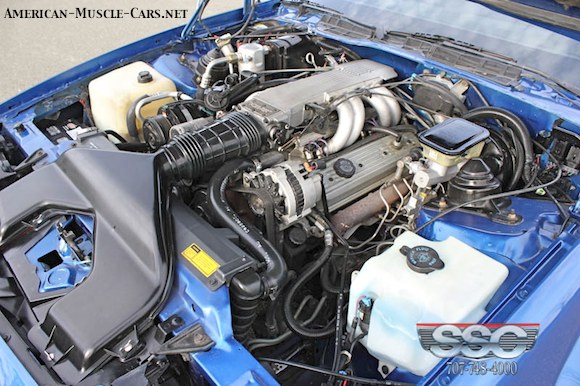
1991 CHEVROLET CAMARO B4C Chevrolet offered a Special Service Package under RPO B4C for the 1991 Camaro that essentially allowed one to order all the mechanicals of a Z28 with all the cosmetics of a standard RS. Sort of a wolf in sheep’s clothing. This was also referred to as the “Police Package” and that is surely what it was, in part. Available only on RS Coupes (no Convertibles), both TPI V8s were available, as were the G92 package (heavy duty 3.23:1 limited slip rear axle, 4-wheel disk brakes, engine oil cooler & dual catalytic converter exhaust system) and 16-inch wheels. It was an expensive option package at $3,135 for the 5.0 and $3,950 for the 5.7, and only 592 were built in 1991.

A WORD ABOUT CHIN SPOILERS ON THE 1991 CHEVROLET CAMARO Z28
If you own a 3rd-gen (1982-92) Camaro or Firebird, you need to know about this. The 3rd-generation F-body cars have a dirty little secret: They’re ‘bottom-breathers’. That means the radiator doesn’t draw its air from the front of the car. The grille you see in the nose only feeds air to the engine intake. If you examine the engine bay photos above, you will notice a Y-shaped black-plastic snorkel that stretches from the throttle body over the top of the radiator, toward the front of the car. This is drawing cool air from in front of the radiator, fed by the front grille. But this area in front of the radiator is actually sealed off from the radiator itself by a black plastic bulkhead that rises at an angle from the front lip of the car to the top of the radiator. There is a large open space in the bottom of the car just behind the nose and in front of the radiator. This is where all the air for the radiator is supposed to come from. One problem though, the air wants to just slip right by and go under the car. So the smart guys at Chevy placed an ‘air diverter’ under the radiator support to direct the air upwards and through the radiator. We always called them a “Chin Spoiler”, and they are about 3 feet wide, are made of black ABS plastic, and mount onto the bottom of the radiator support with 6 or 8 sheetmetal screws. So far so good. The problem is that these Chin Spoilers hang pretty low and tend to scrape on things like speed bumps and driveways. So over the years, many people have removed them, or they got knocked off. Some people even thought they would improve the car’s aerodynamics if they removed it (like the engineers didn’t realize that!). But as soon as you remove it, the problems start. Now the radiator can’t get enough air and it starts to run hot all the time. The computer will kick the electric fan on at about 210 degrees, but it will still run hot. So many people hotwire the fan so it runs all the time. It still runs hot, and it gets worse on the freeway, which is sort of counter-intuitive. What’s going on here? Wouldn’t the higher airflow at freeway speeds help cool it down? Not in this case. Because, in the absence of a Chin Spoiler the air slips right by the radiator compartment at lower speeds, but at higher velocities, the fast-moving air creates a low-pressure area in front of the radiator, making it nearly impossible for the electric fans to overcome it and pull enough air through. If you’ve been having cooling problems with your 3rd-generation Camaro or Firebird, go out into your garage right now, get on all fours with a flashlight and see if you have a Chin Spoiler or not. Again it’s black plastic, hangs down about 4 inches by about 3 feet wide, runs side-to-side along the bottom of the radiator support. Pretty hard to miss. If you don’t have one, I can virtually guarantee you that this is the source of your overheating problems. Try to find one in a wrecking yard if you can. They’re all the same for all Camaros and Firebirds from 1982 through 1992.
1991 Chevrolet Camaro PRODUCTION NUMBERS
| RPO
1FP87 1FP87 1FP87 1FP87 1LE B4C B2L LB9 G80 G92 J65 KC4 N96 |
DESCRIPTION
Camaro RS Coupe, 6-cylinder Camaro RS Convertible, 6-cylinder Camaro Z28 Couple, 8-cylinder Camaro Z28 Convertible, 8-cylinder Special Performance Components Package Special Service Package, RS Coupe only 5.7 liter/350 ci TPI V8, Z28 only 5.0 liter/305 ci TPI V8 Limited Slip Differential Peformance Axle Package, Z28 only 4-wheel Disk Brakes Engine Oil Cooler, Z28 only 16″ Aluminum Wheels |
QUANTITY
79,854 5,329 12,452 3,202 478 592 6,080 9,996 16,333 6,813 4,938 7,234 53,249 |
RETAIL
12,180.00 17,960.00 15,445.00 20,815.00 * 3,135.00 300.00 nc 100.00 466.00 179.00 110.00 520.00 |
1991 Chevrolet Camaro SPECIFICATIONS
| Wheelbase
Length Width Height Track, front Track, rear Curb weight ENGINE OPTIONS: LH0 3.1L OHV V6 L03 5.0L OHV V8 w/TBI (RS only) LB9 5.0L OHV V8 w/TPI (Z28 only) B2L 5.7L OHV V8 w/TPI (Z28 only) TRANSMISSION OPTIONS: Automatic Manual |
101.0″ / 2565 mm
192.6″ / 4892 mm 72.4″ / 1839 mm 50.4″ / 1280 mm 60.0″ / 1524 mm 60.9″ / 1546 mm 3318 lbs / 1505 mm 140 hp @ 4400 rpm / 180 lb-ft @ 3200 rpm 170 hp @4800 rpm / 255 lb-ft @ 2400 rpm 205 hp @ 4200 rpm / 285 lb-ft @ 3200 rpm 230 hp @ 4400 rpm / 345 lb-ft @ 3200 rpm 700R4 4-speed automatic w/overdrive Borg Warner T5 5-speed |


